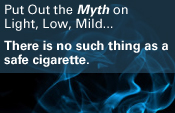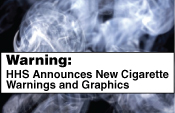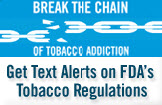At least since the early 1990’s, governments have been passing
laws that restrict outdoor tobacco advertising. However, only a Baltimore
ordinance banning billboards in residential neighborhoods stood up to
court challenges.
The following chart shows the recent history of laws restricting outdoor
tobacco advertising and details of the court cases that followed.
Definition of legal precedents
Preemption Clause
Federal Cigarette Labeling and Advertising Act
(enacted 1965, amended 1969 as part of the “Public Health Cigarette
Smoking Act”)
U.S. Code TITLE 15 > CHAPTER 36 > § 1334 [15 U.S.C. 1334]
§ 1334. Preemption
(a) Additional statements
No statement relating to smoking and health, other than the statement
required
by section 1333 of this title, shall be required on any cigarette
package.
(b) State regulations
No requirement or prohibition based on smoking and health shall be
imposed
under State law with respect to the advertising or promotion of any
cigarettes the
packages of which are labeled in conformity with the provisions of
this chapter.
U.S. Constitution “Supremacy Clause”
Article VI, clause 2. The laws of the United States “shall be
the supreme Law of the Land; … any Thing in the Constitution or
Laws of any State to the Contrary notwithstanding.”
First Amendment Protection of Commercial
Speech
Since 1980, a Supreme Court decision known as “Central Hudson”
has provided a four-part test for regulating commercial speech. The
four questions are:
1. Is the speech truthful and related to a lawful activity?
2. Is the asserted governmental interest substantial?
3. Does the regulation directly advance the government’s interest
asserted in question 2?
4. Is the regulation not more restrictive than is reasonably necessary?
The laws regulating cigarette ads were decided
on the basis of pre-emption by the FCLAA. The First Amendment was
used in the Massachusetts case for smokeless and cigars.
Most of the tobacco regulations that were challenged
failed only the 4th question. The Court did not question the importance
of keeping kids away from tobacco (part 2), and that restricting tobacco
ads is effective in keeping kids away from tobacco (part 3.)
| Who: |
City of Baltimore, MD |
| When: |
1994 |
| Title: |
Ordinance 307 |
| Regulation: |
Banned all tobacco billboards except in industrial and some commercial
zones. |
| Challenge: |
U.S. Court of Appeals for the 4th Circuit (decided August 1995) |
·
| Ruling: |
In favor of the Ordinance.
• ".neither federal nor state law preempts the operation
of Baltimore's ordinance and . the ordinance is a permissible regulation
of commercial speech under the four-part test announced in Central
Hudson." |
| Comments: |
All tobacco billboards were later banned by the 1998 Master Settlement
Agreement (MSA.) |
|
|
| Who: |
New York City |
| When: |
1998 |
| Title: |
Article 17-A: "Youth Protection against Tobacco Advertising and
Promotion Act" |
| Intent: |
"to strengthen compliance with and enforcement of laws prohibiting
the sale or distribution of tobacco products to children and to
protect children against such illegal sales." |
| Regulation: |
Within 1,000 feet of a school, playground, day care, arcade or
youth center:
• Banned outdoor tobacco ads.
• Prohibited indoor tobacco ads from being placed where they
could be seen from outside.
• Allowed "tombstone" signs placed within 10 feet of store
entrance stating, "Tobacco products sold here." Sign specs: max
6 square feet, black text only, max 8-inch letter height. |
|
| Challenge: |
U.S. District Court, Southern District of NY (decided December
1998) |
| Ruling: |
Against the law.
• ".the Court DECLARES that Article 17-A . is preempted
by the Federal Cigarette Labeling and Advertising Act (FCLAA) and
the Supremacy Clause of the United States Constitution , and therefore,
is without force or effect." |
| Appeal: |
U.S. Court of Appeals for the 2nd Circuit (decided October 1999) |
·
| Ruling: |
In favor of the 1,000 foot ban part of the law, against the tombstone
sign part of the law.
• ". we AFFIRM the judgment of the district court insofar
as it held that the tombstone provision of Article 17-A is preempted
under the FCLAA, REVERSE insofar as it [the District Court] held
that the remaining provisions of Article 17-A are preempted." |
| Comments: |
The 1,000 foot ban was declared unconstitutional by the U.S. Supreme
Court in the 2001 Lorillard v. Reilly decision. |
| |
| Who: |
Tacoma-Pierce County [WA] Health Department Board of Health |
| When: |
1996 |
| Title: |
Tacoma-Pierce County Health Department Board of Health Resolution
No. 96-1997 |
| Intent: |
"[t]obacco advertising, whether intended to promote tobacco use
or only compete for market share, has the consequence of promoting
tobacco use" and "[t]obacco advertising induces children to initiate
tobacco use." |
| Regulation: |
• Banned all tobacco advertising (outdoor or indoor) that
could be seen from the street, unless presented in a "tombstone"
format.
• Banned display of any tombstone ads that would be visible
from a school, school bus stop, sidewalk regularly used by minors
to get to school, or within 1,000 feet of a school, playground or
public park. |
| Challenge: |
U.S. Court of Appeals for the 9th Circuit (decided November 1999) |
| Ruling: |
Against the law.
• ".a local ban on outdoor tobacco advertising is preempted
by the Federal Cigarette Labeling and Advertising Act." |
| Comments: |
|
| |
| Who: |
U.S. Food & Drug Administration (FDA) |
| When: |
1996 |
| Title: |
Regulations Restricting the Sale and Distribution of Cigarettes
and Smokeless Tobacco to Protect Children and Adolescents. |
| Intent: |
|
| Regulation: |
• Ban outdoor tobacco ads within 1,000 feet of any public
playground or school.
• Require all print ads be text-only, black & white, except
in publications read "almost exclusively" by adults.
• Ban distribution of tobacco company branded promotional
items or gear.
• Ban tobacco industry from using brand names to sponsor social
or cultural events |
| Challenge: |
U.S. Supreme Court (decided March 2000) |
| Ruling: |
Against the regulation on the grounds that the FDA did not have
congressional authority to regulate tobacco.
• ".an administrative agency's power to regulate in the public
interest must always be grounded in a valid grant of authority from
Congress." |
| Comments: |
Writing for the majority, Justice O'Connor affirmed the social
impact of the tobacco problem.
• "This case involves one of the most troubling public health
problems facing our Nation today: the thousands of premature deaths
that occur each year because of tobacco use. By no means do we question
the seriousness of the problem that the FDA has sought to address.
The agency has amply demonstrated that tobacco use, particularly
among children and adolescents, poses perhaps the single most significant
threat to public health in the United States." |
| |
| Who: |
State of Massachusetts (Attorney General Reilly) |
| When: |
1999 |
| Title: |
940 Code of Mass. Regs. 21.01-21.07, 22.01-22.09 (2000) |
| Intent: |
For the cigarette and smokeless tobacco regulations: ".to eliminate
deception and unfairness in the way cigarettes and smokeless tobacco
products are marketed, sold and distributed in Massachusetts in
order to address the incidence of cigarette smoking and smokeless
tobacco use by children under legal age .... [and] in order to prevent
access to such products by underage consumers." |
| Regulation: |
For any locations within 1,000 feet of any public playground,
playground area in a public park, elementary or secondary school:
• bans outdoor advertising of tobacco products;*
• bans indoor advertising that is directed toward or
visible from the outside;
• bans any point-of-sale tobacco ads (or portion of
ads) placed lower than 5 feet above the floor.
For anyone selling or distributing through a retail outlet:
• bans using self-service displays of cigarettes and
smokeless tobacco products, cigars and little cigars;**
• requires products to be out of customers' reach and
accessible only to retail staff |
| Challenge: |
U.S. Supreme Court (decided June 2001) |
| Ruling: |
Against all advertising restrictions related to cigarettes.
• ".we hold that the Attorney General's outdoor and point-of-sale
advertising regulations targeting cigarettes are pre-empted by the
FCLAA."
• ". it is understandable for the States to attempt to prevent
minors from using tobacco products. Federal law, however, places
limits on policy choices available to the States."
Against all advertising restrictions related to cigars and smokeless
tobacco as violations of the First Amendment as tested by Central
Hudson's fourth step.
• ".Whatever the strength of the Attorney General's evidence
to justify the outdoor advertising regulations, however, the regulations
do not satisfy Central Hudson's fourth step. Their broad sweep indicates
that the Attorney General did not "carefully calculat[e] the costs
and benefits associated with the burden on speech imposed."
In favor of retail sales practices restricting access to all tobacco
products.
• "The State has demonstrated a substantial interest in preventing
access to tobacco products by minors and has adopted an appropriately
narrow means of advancing that interest. [.]It is clear that the
regulations leave open ample communication channels." |
| Comments: |
The Court wrote that there was, "ample documentation of the problem"
with underage tobacco use, and that "preventing targeted advertising
campaigns and limiting youth exposure to advertising will decrease
underage use of those products." |
|
|


